|
< Earlier Kibitzing · PAGE 2 OF 2 ·
Later Kibitzing> |
| Dec-26-14 | | patzer2: Christmas is the gift that keeps on giving at chessgames.com as there are, according to Fritz 12, at least 20 solutions to this Friday Dec 26th puzzle. My try was 31. Rf8+ Nxf8 32. Rxf8 Ke7 33. Qc8 Rd7, and instead of 34. Na7 I found 34. Nc7  which takes two to three moves to mate instead of just one to mate after the game move. which takes two to three moves to mate instead of just one to mate after the game move. |
|
| Dec-26-14 | | patzer2: Black was in trouble early in the opening. According to the chessgames.com opening explorer, White has a 100% winning record (7 wins and 0 losses) in this opening after 5. h4  . .After 14. f4, Fritz has White winning with nearly a three pawn advantage. |
|
| Dec-26-14 | | CHESSTTCAMPS: White is up a pawn and controls the f-file with the doubled rooks, while the black rooks passively defend the 7th rank. Clearly white is looking for a final breakthrough. First I looked at the interference sacrifice 31.Rf6 with the idea of getting the Q to e6 or the N to d6 with tempo. Then I saw a better way to put this together. 31.Rf8+!!
The back rank is the soft underbelly of the black position. An exchange sacrifice is cheap price to pay for creating an entry point for the white queen. A. 31... Nxf8 32.Rxf8+ Ke7 33.Qc8 (threatening Qd8#) Rd7 34.Na7! Rxa7(or Rc7) 35.Qd8# A.1 34... other 35.Nc6#
B) 31... Ke7 32.R8f6! (a much better time to use this idea) Nxf6 33.Qe6+ Kd8 (Kf8 34.Rxf6+ wins Q) 34.Rxf6 Qe8 (Qxg5 35.Rf8#) 35.Qxd6+ B.1 35... Qd7 36.Rf8#
B.2 35... Rbd7 36.Qb8+ Ke7 37.Re6+ wins
B.3 35... Kc8 36.Rf8 wins
B.4 35... Rhd7 36.Rf8! Rxd6 (36... Qxf8 37.Qxf8#) 37.Rxe8+ Kxe8 (other 38.Nxd6 wins) 38.Nxd6+ followed by 39.Nxb7 wins. Time for review... |
|
| Dec-26-14 | | Dr. J: <CHESSTTCAMPS> Nice analysis (better than mine) but there remain some variations that you missed: <31.Rf8+!! ...
B) 31... Ke7 32.R8f6! Nxf6 33.Qe6+> (much better than 33.Rxf6 Qg8) <Kd8 (Kf8 34.Rxf6+ wins Q) 34.Rxf6 Qe8 (Qxg5 35.Rf8#)> Here Black also has 34...Qg7, answered by 35.Nxd6 Rb8 (appears forced; if 35...Qd7 36.Rf8+ Kc7 37.Nb5+ Qxb5 38.Rc8#) 36.Nf7+ wins. <35.Qxd6+ ...
B.4 35... Rhd7 36.Rf8! Rxd6 (36... Qxf8 37.Qxf8#) 37.Rxe8+ Kxe8 (other* 38.Nxd6 wins) 38.Nxd6+ followed by 39.Nxb7 wins.> *Somewhat better for Black is 37...Kxd6 38.Nxd6 Kxd6 39.Re6+ Kd7 40.Rxe5, and she can continue to fight out a relatively hopeless ending. Did <cg.com> miss that 31...Ke7 is possible, and 31...Nxf8?? is a serious mistake? |
|
| Dec-26-14 | | stacase: Played it move for move. Sometimes you see these things and other times not. |
|
| Dec-26-14 | | diagonalley: <The17thPawn> ...me too! |
|
| Dec-26-14 | | morfishine: I had the first move and followed the game up to 33...Rd7 <31.Rf8+> 31...Nxf8 32.Rxf8+ Ke7 33.Qc8 Rd7 But instead of 34.Na7 I continued <34.Rg8> Qf7 35.g6 which
looks fairly crushing
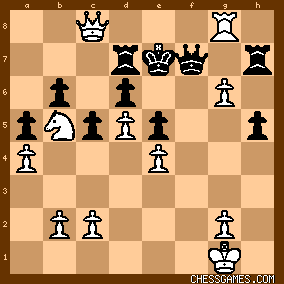
click for larger view***** |
|
| Dec-26-14 | | Viennablue: 12...Nh7? seems an awful, unnecessary move to me. After 12...Nbd7 and/or castling some work remains to be done by White |
|
| Dec-26-14 | | gofer: Well, I think we can force an exchange of rook for bishop and get the king to move
to e7 at which point we have the huge threat of Qe6, so we play Rf6 forcing the king
to g8 and from then on the disconnected rooks and disorganised queen is no match for
our N, R and Q.
<31 Rf8+ ...>
Black cannot accept!
31 ... Nxf8
32 Rxf8+ Ke7
33 Qf8! Rd7
34 Nh7! Rxh7
35 Rxh7 Qe8#
<31 ... Ke7>
<32 R3f6 ...>
Threatening Qe6#
32 ... Nxf8
33 Rxg6 Nxf6
34 Qe6+ Kf8 (Kd8 Qg8+ Nf8 g6!  ) )
35 Qc8+ 
<32 ... Nxf6>
<33 Rxf6 ...>
33 ... Qxg5+/Qxe4
34 Qe6+ Kd8
35 Rf8#
<33 ... Qg8>
<34 Nxd6 ...>
White threatens Nxb7, so Rb7 must move and saving the rook loses the queen! But losing the rook
loses the game, so either way black is sunk...
34 ... Rd7
35 Re6+ Kd8
36 Re8+ Qxe8
37 Nxe8 Kxe8
38 g6! 
<34 ... Rc7>
<35 Re6+ Kd8> (Kd7 Re8+) <36 Re8+ Qxe8>
<37 Nxe8 Kxe8>
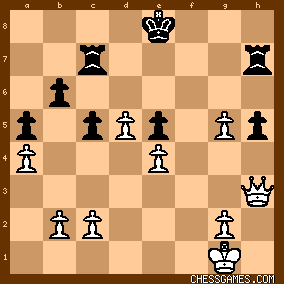
click for larger viewAt this point the pawns on g5 and d5 do the damage!!! <38 d6! Rcd7>
<39 g6 Rhg7>
<40 Qxh5 Kf8>
<41 Qh8+ Rg8>
<42 Qf6+ Ke8>
<43 Qe6+ > 

click for larger view~~~
Merry Christmas everyone! |
|
| Dec-26-14 | | scholes: 31 Rf8+ NXR 32 RXN+ Ke7 33 Qc8 threatening Qd8# Rd7 34 Rg8 threatening both Qe8# and Qf8# therefore QxRg8 35 QxQ Rf7 white gives 2 rooks for night and queen and winning.
So back to first discretionary move
31 ..Ke7 instead of NxR then 32 Rf3f6 NxR 33 rf8f6 Qg8 and white has nothing so instead 33 Qc8 threatening Qd8# Rd7 34 gxN+ Qxg 35 Rxg Kxg 36 Qe6 + and white wins |
|
Dec-26-14
 | | Penguincw: My guess was 31.Rf6 Nxf6 32.Rxf6 and grabbing on d6, but g5 is hanging now... |
|
| Dec-26-14 | | Cheapo by the Dozen: White, who is up a pawn, has three main potential avenues of attack: the f-file, the h3-c8 diagonal, and Nxd6. So the two main candidate moves to start an attack are Rf6 and Rf8+, both of which are exchange sacrifices. The natural Rf8+ line is: 31 Rf8+ Nxf8
32 Rxf8+ Ke7
33 Qc8 Rd7
It's not obvious how White proceeds from there, nor how he proceeds if Black plays 31... Ke7 instead. So let's consider the alternative: 31 Rf6 Nxf6
32 Rxf6 Qxg5
33 Rxd6+ Ke8
34 Qe6+
Mate will happen soon.
Black's main options to deviate are to forgo the exchange grab and/or to play the queen to a more defensive square (e8 or g8). If he does both those things, the White can grab a second pawn with Rxd6 and have a strong advantage; no need to calculate if there's something sharper that's better yet. Suppose Black grabs the exchange and then retreats; we could have: 31 Rf6 Nxf6
32 Rxf6 Qe8/Qg8
33 Rxd6+ Ke7/e8
34 Re6+
Right there we see that the Black queen most have gone to g8 rather than e8, else it would be lost now. (The Nxd6 fork also shows this.) So let's reset this line to: 31 Rf6 Nxf6
32 Rxf6 Qg8
33 Nxd6
White now threatens Qc8+, winning Black's queen, along with Nxb7+. Also, he is marginally ahead in material. Also, he's threatening Qf5/Rf8+, winning the queen. I don't see how Black can defend against all these threats, especially since ... Ke7 can be met by Re6+/Re8+, after which White would have queen and several pawns (two of them passed on the 5th rank) against a rook pair. The other possibility is that Black goes for an active response, as in 31 Rf6 Nxf6
32 Rxf6 Qxe4/Qxg5, perhaps with the idea of ... Qg4 trying for a queen exchange. 33 Nxd6 now attacks the b7 rook, and also threatens a couple of mates: Qc8+/Qe8+/Qe6# and similarly Rf8+/Re8+/Qe6+/Qc6# (or similarly if Black's king runs to c7 instead of e7). So the only try at a defense is ... Rb8. But that in turn allows lines like 33 Rf8+ Kc7
34 Rxb8 Kxb8
35 Qc8+ Ka7
36 Nb5# |
|
| Dec-26-14 | | Cheapo by the Dozen: As usual, I overcomplicated things, in this case because I didn't see the maneuver Na7/Nc6. |
|
| Dec-26-14 | | Edeltalent: 31.? White to move
The position is rather closed. White is a pawn up, but really his advantage comes from his considerably more active rooks (controlling the only open file) and knight, also the black king doesn't feel so safe in the middle. 31.Rf8+ and 31.Rf6 are the first moves that come to mind. 31.Rf6 Nxf6 32.Rxf6 Qxe4 33.Rxd6+ Rbd7 doesn't look too great, black's rooks defend well on the 7th rank and the black queen suddenly has a lot of activity and a potential perpetual check on e1-h4 if the white queen tries to penetrate. So 31.Rf8+ Nxf8 32.Rxf8+ Ke7 33.Qc8 Rd7 (the only defense against Qd8#). The white pieces are extremely threatening and Black has no counterplay at all. He for now has all squares of his backrank covered, but once you realize that the white knight is not actually participating in the attack and look for ways to get him involved, you discover that 34.Na7 is the final blow. The knight can't be taken because of Qd8#, but there is no other defense against Nc6#. Black thus has no choice but to refuse the rook at the beginning with 31.Rf8+ Ke7. Now with the king on e7, queen or rook would come to e6 with check, so blocking out the black queen from the defense by interposing on f6 gains in strength. White has the pleasant choice between 32.R8f6 and 32.R3f6, which both look very strong. 32.R3f6 Nxf6 33.Rxf6 (not 33.Qe6+ Kxf8 or 33.Qc8 Ne8) Qg8 34.Nxd6 Rd7 35.Re6+ Kd8 36.Re8+ Qxe8 37.Nxe8 Kxe8 38.Qe6+, and the white queen will collect most black pawns and win without problems. 32.R8f6 Nxf6 (Qg8 33.Nxd6 is even worse than in the previous variation) 33.Qe6+ Kd8 34.Rxf6 Qe8 35.Qxe8+ Kxe8 36.Nxd6+, and again the ending is an easy win. |
|
| Dec-26-14 | | varishnakov: I missed the key move. I got up to 33...R-Q2 which I just thought defended so I started looking for other solutions. Didn't consider the great move 34.N-R7! after which the two mate threats cannot both be met. So because of this, I switched to 33.R-B6 Q-N1 34.R-K6+ with a strong attack, though without clear continuations, for me. |
|
| Dec-26-14 | | kevin86: The queen comes behind black's forces and set up mate...by a knight! |
|
| Dec-26-14 | | CHESSTTCAMPS: <Dr. J> Good points. I should have analyzed 34... Qg7 at least for completeness. |
|
Dec-26-14
 | | Jimfromprovidence: I got 31 Re8+ Ke7 32 R8f6 Nxf6 33 Rxf6, below.
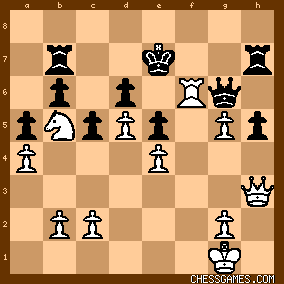
click for larger viewNext comes 33...Qg8 34 Nxd6 Rb8 35 Re6+ Kd8 36 Re8+.
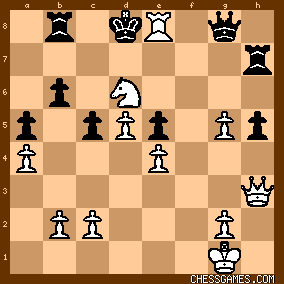
click for larger viewFinally 36...Qxe8 37 Nxe8.
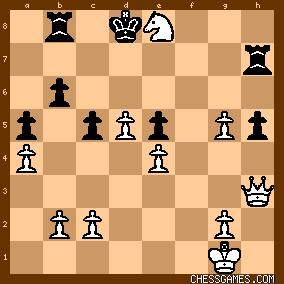
click for larger viewThe knight is untouchable because if 37...Kxe8 then 38 Qe6+ will win one of the rooks. I know that there are many subvariations which I have conveniently chosen to ignore. |
|
| Dec-26-14 | | BOSTER: I'd say it was the <Deep Thought > creating a classic pinning chain, where the knight d7 the pinned piece and the square
c8 was the target ,playing 30.Qh3. |
|
| Dec-26-14 | | Lighthorse: <diagonalley: <The17thPawn> ...me too!> Me three! |
|
| Dec-26-14 | | agb2002: White is one pawn ahead.
The first idea that ccomes to mind is 31.Rf8+, to invade Black's field: A) 31... Nxf8 32.Rxf8+ Ke7 (32... Qe8 33.Rxe8+ Kxe8 34.Qc8+ and 35.Qxb7+) 33.Qc8 (threatens 34.Qd8# and 34.Rf6; 33.Rf6 Qg8 34.Re6+ probably wins) 33... Rd7 34.Nc7 seems to win (threatens 35.Re8+; 34... Rxc7 35.Qd8#; 34... Rf7 35.Q(R)e8#). B) 31... Ke7 32.Ra8 (threatens 33.Rf6 and 34.Qe6#) 32... Rb8 (32... Nb8 33.Qc8 wins material) 33.Ra7 B.1) 33... Rd8 34.Rf6 Qg8 35.Qe6+ (35.Re6+ Kf8 36.Nxd6 also looks winning) 35... Qxe6 36.dxe6 wins the knight. B.2) 33... Kd8 34.Rxd8+ Rxd8 35.Rf8+ Ke7 36.Rxb8 wins the knight. B.3) 33... Ke8 34.Nc7+
B.3.a) 34... Kd8 35.Ne6+ Ke8 (35... Kc8 36.Rc7#) 36.Rxd7 Rxd7 (36... Kxd7 37.Nf8+ wins the queen) 37.Rf8+ Ke7 38.Rxb8 wins the knight. B.3.b) 34... Ke7 35.Qxd7+ Kxd7 36.Ne6+ Rb7 (else 37.Rf8+ mates) 37.Nf8+ Kc8 (37... Kd(e)8 38.Ra8+ and 39.Nxg6 + -; 37... Ke7 38.Nxg6+ + -) 38.Ra8+ Rb8 39.Rxb8+ Kxb8 40.Nxg6 + -. Probably there is a simpler way to win. |
|
| Dec-26-14 | | agb2002: <CHESSTTCAMPS> Nice to see you again Phil! |
|
| Dec-26-14 | | Longview: I had similar candidate moves to <Jimfromprovidence> 31. R-f6 and <Jimfromprovidence> 31. R-f8+ which I thought was the most advantageous but I could not make good progress by forced moves to create capitulation. I saw the moves as it was played but did not see 33. N-a7 as the clincher. I agree with <patzer2>'s discovery of multiple approaches. It seems that white has a grip on the King but the knife is not yet in the back (at least I could not find the final opening to deliver the blow!) Happy Holidays to all puzzlers. |
|
| Dec-26-14 | | CHESSTTCAMPS: <agb2002 <Nice to see you again Phil!>> Thanks. It's always nice to see you and your analysis, also! |
|
| Dec-26-14 | | Prosperus: 34. Nc7 also wins with an idea 35. Re8+ Qxe8 (35. ... Kf7 36. Qxd7#) 36. Qxe8# Black doesn't have defense: 34. ... Rxc7 35. Qd8# |
|
 |
|
< Earlier Kibitzing · PAGE 2 OF 2 ·
Later Kibitzing> |





